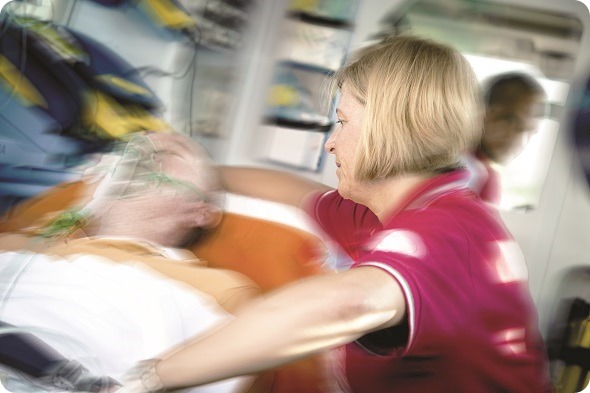Why has the observation time to rule-in or rule-out a heart attack traditionally been around 6-12 hours?
Cardiac troponin is a highly sensitive and specific biomarker for myocardial injury but concentrations in the blood rise over several hours after the onset of an acute myocardial infarction.

This meant that many patients had troponin levels within the normal range when they first presented to the Emergency Department but, on repeat testing hours later, the levels had risen to become abnormal.
Consequently, all patients underwent serial testing over several hours before the diagnosis of an acute myocardial infarction could be considered ‘ruled out’.
With previous versions of the test, patients either had completely undetectable levels of troponin (which were normal) or detectable levels that were abnormal.
This meant that a positive result was defined by how good the test was at detecting small concentrations of troponin, rather than by the presence or absence of actual myocardial injury.
Many of the patients with acute myocardial infarction had normal levels of troponin initially but would develop a rise over the course of the next 6 to 12 hours. In order to detect these late rises, all patients underwent repeat testing after 6 to 12 hours.
How important is a fast and reliable diagnosis of heart attack in terms of patient outcome?
A missed acute myocardial infarction could be devastating for patients. Mortality rates for heart disease have been declining for many years, which is at least in part testament to significant advances in treatment.
If the condition is not diagnosed, patients cannot benefit from that treatment. Research has previously shown that patients with acute myocardial infarction who have their diagnosis ‘missed’ initially have a worse prognosis than similar patients who were correctly identified.
It is important that we do this as quickly as possible. Chest pain is the most common reason for emergency hospital admission in England and Wales.
After investigations have been completed, most patients who are admitted because of a suspected acute coronary syndrome will actually have that diagnosis ‘ruled out’.
Reducing the number of unnecessary admissions will help to unburden crowded hospitals and Emergency Departments and faster investigation protocols for patients with chest pain will greatly help in that regard.
What is troponin and why is it released during a heart attack?
Cardiac troponin is a protein that is contained within heart muscle cells, which helps the muscle to contract and the heart to pump.
Troponin is contained in all muscle cells but modern tests can specifically detect the ‘cardiac troponin’ that is released by heart muscle.
In healthy people, cardiac troponin should be mainly located inside heart muscle cells with very little circulating in the bloodstream.
In patients who have had a heart attack, some of the heart muscle cells are injured and their contents can spill out into the bloodstream. When that happens, we can detect the cardiac troponin with blood tests.
How much do troponin tests differ in terms of sensitivity and how does this impact how long they take to detect troponin release?
There is a large difference in the sensitivity of different troponin tests. We can measure the performance of troponin tests in two main ways.
First, we can look at the analytical sensitivity of the test, which looks at the smallest concentrations of cardiac troponin that can be detected by the test.
We try to standardise this by reporting the proportion of healthy people who have troponin concentrations that can be detected by the test. For some of the older tests, less than 1% of healthy people have detectable troponin concentrations.
The newer ‘high sensitivity’ tests can detect troponin levels in at least 50% of healthy individuals. In clinical practice, detecting smaller concentrations of troponin can be helpful because we can set the ‘cut-off’ below the traditional level.
Although it may still take several hours for troponin levels to rise above traditional diagnostic cut-offs in patients with acute myocardial infarction, troponin levels in those patients will pass lower thresholds earlier. Thus, more sensitive tests could be used to ‘rule out’ acute myocardial infarction much earlier, if we use ‘cut-offs’ set below the usual thresholds.
Second, we can look at the ‘precision’ of the test. If we test the same blood sample several times, we might get slightly different results on each occasion. With a more precise test, those results will be closer together with less variation.
Some of the older tests have very suboptimal precision when making small troponin concentrations but this has improved considerably with the newer ‘high sensitivity troponin’ tests.
This means that, when testing the same patient’s blood over time, we can be more confident that any change we see is real and not because the test itself is simply imprecise.
Because we can detect smaller changes, we can then reduce the time taken to detect patients with acute myocardial infarction, in whom troponin levels are rising over time.
.jpg)
Can you please give a brief overview of the TRAPID-AMI clinical study?
TRAPID-AMI was a multi-centre, international study, which recruited at 12 centres in 9 countries. We included patients who presented to the Emergency Department with possible acute coronary syndromes.
All of the patients we included had presented early (less than 6 hours) after their symptoms began. In this observational study, we tested blood samples for high sensitivity cardiac troponin T and compared the results against the final diagnosis, which was determined by an expert panel.
The main objective was to determine whether it may be possible to safely determine which patients do and do not have an acute myocardial infarction using high sensitivity cardiac troponin T tests undertaken on arrival and 1 hour later.
Previous research had suggested that it may be possible to do this but the findings needed to be confirmed in a large study.
What were the main findings of the study?
TRAPID-AMI found that it may be possible to ‘rule out’ the diagnosis of acute myocardial infarction using high sensitivity cardiac troponin T tests on arrival and 1 hour later.
Using this algorithm, approximately two out of three patients could be told that they do not have a heart attack and could potentially avoid an unnecessary hospital admission.
Using these two tests an hour apart, the algorithm correctly identified approximately 97% of all patients with an acute myocardial infarction, meaning that we can reassure these patients with a fair amount of confidence.
However, the algorithm does more than reassure people who don’t have an acute myocardial infarction. It also helps to confirm which patients actually have the diagnosis, meaning that they can receive healthcare in the most appropriate environment and receive the appropriate treatment in a timely way.
What impact do you think the ability to detect heart attacks in 1 hour will have on patient outcomes?
We don’t, as yet, have any evidence to suggest that identifying heart attacks within 1 hour means that the outcome of those patients will improve. This is an area for future work.
However, the main benefit of this algorithm will be to enable earlier reassurance for patients who do not have acute myocardial infarction. For those patients, avoiding unnecessary hospital admission could be very positive.
Being in hospital can be uncomfortable and having tests for a suspected heart attack is worrying. The impact of this is felt by both patients and their relatives.
With the use of algorithms such as the 1 hour algorithm evaluated in TRAPID-AMI, we hope that patient outcomes will be the same but that the algorithm will mean fewer patients spend unnecessary time in hospital.
What changes are needed in clinical practice to incorporate the 1-hour algorithm?
The algorithm does require resources in the Emergency Department. Patients must undergo two blood tests and have a rapid medical review by a doctor once the results are available.
In crowded and pressurised Emergency Departments, this will be difficult to achieve without increasing existing resources. However, the advantages of avoiding unnecessary hospital admissions are clear so I hope that this resource need can be filled.
The other question is whether clinicians are willing to accept that 3% of all acute myocardial infarctions could be missed by the algorithm.
Intuitively, clinicians may feel uncomfortable with this. However, by integrating the algorithm with clinical judgement and a careful clinical assessment, it is likely that the true rate of missed diagnoses is far less than this. Future research to evaluate the impact of using the algorithm in practice will be helpful in this regard.
How do you think heart attack diagnosis will advance in the future?
I think we’ll start to see the introduction of algorithms like this 1-hour algorithm being used in clinical practice, although it may take a little more research to convince doctors that it’s safe and effective.
We’re also likely to see additional algorithms that can allow some patients to be reassured following just a single blood test.
The algorithms could be ‘joined up’ so that some patients go home after the first test with more going home after 1 hour. I think we’re also likely to see more focus on positively identifying the patients who do have an acute myocardial infarction and more research evaluating the benefits of early treatment in that group.
About Dr Body
Rick Body is a Professor of the Royal College of Emergency Medicine who works as an academic Consultant and Research Director for Emergency Medicine at Central Manchester University Hospitals NHS Foundation Trust, United Kingdom. He is also an Honorary Senior Lecturer in Cardiovascular Medicine at the University of Manchester.
Following his PhD in the derivation of clinical decision rules for suspected cardiac chest pain, Dr. Body developed the Manchester Acute Coronary Syndromes (MACS) decision rule. He was also the first to report on the value of a single test rule out strategy using high sensitivity troponin with a novel cut-off set at the limit of detection and he is currently the chief investigator for the Bedside Evaluation of Sensitive Troponin (BEST) study.
Dr. Body is an Associate Editor at the Emergency Medicine Journal, the Deputy Chair for Injuries & Emergencies research at the National Institute for Health Research, and he sits on the Research Committees for the Royal College of Emergency Medicine and European Society of Emergency Medicine.
He has advised the UK National Institute for Health and Care Excellence on cardiac biomarkers, high sensitivity troponin, stable chest pain and non ST elevation acute coronary syndromes. Dr. Body is a Senior Editor at the St. Emlyn’s international blog and podcast (www.stemlynsblog.org).